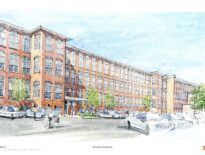
Development-friendly zoning, transit connections to North Station’s growing job cluster and Lynn’s rising public art profile laid the groundwork for one of the city’s largest developments since the Industrial Revolution. Photo by Steve Adams | Banker & Tradesman staff
If passed, President Joe Biden’s new, proposed $2 trillion infrastructure package could help jump-start a handful of long-sought transit projects in Massachusetts but advocates say, but warn the state has to hurry if it wants fundable projects ready for building.
Among its many proposed investments, the Biden plan announced yesterday would spend $85 billion nation-wide on public transit infrastructure and $80 billion modernizing inter-city rail service, including Amtrak’s Northeast Corridor between Washington, D.C., New York City and Boston.
“If traditional transit formulas hold, Massachusetts would likely see something like $3 billion of that. That’s a lot, but it doesn’t suddenly turn us into Wakanda,” Transportation for Massachusetts Executive Director Chris Dempsey said in an email to Banker & Tradesman, referring to the fictional techno-paradise homeland of Marvel’s Black Panther superhero.
East-West Rail a Likely Candidate
With that money, Massachusetts could pay for three projects on the scale of the MBTA’s billion-dollar Green Line Extension or South Coast Rail, Dempsey said. In addition to money it might get from the inter-city rail portion of the bill, the state could make a “down payment” on a proposed East-West Rail train service between Boston, Worcester and Springfield, with a potential extension to the Berkshires and beyond, which previous state studies estimate would cost between $2.4 billion and $4.6 billion. The state’s regional transit authorities, which provide bus service outside the Route 128 area, could also “check off some important projects” with new federal investments, he said.
LivableStreets Alliance Executive Director Stacy Thompson said the much-debated Interstate 90 Allston Interchange project was also a likely candidate for federal funding, given its advanced planning state and its transit element: a combination bus-commuter rail hub that would serve the rapidly growing Allston neighborhood.
South Boston Congressman Stephen Lynch lavished praise on the East-West Rail project as a way to deal with the Boston area’s high housing costs and economic struggles elsewhere in the state during a speech to the New England Council earlier this week.
“We realize as a state and as a delegation, the East-West Rail piece … is so important to opening up the housing opportunities,” said Lynch, who sits on the House Committee on Transportation and Infrastructure, noting that “we lose a lot of talent in Boston and New England because of housing prices.”
Advocates Tout Transformative Potential
Transit Matters Executive Director Jarred Johnson noted that the Biden bill could also help pay to connect the MBTA’s Red and Blue lines in downtown Boston and to transform parts of the region’s commuter rail system into subway-like, electrified “regional rail,” where trains come frequently throughout the day.
The MBTA’s Fiscal and Management Control Board backed a plan in 2019 to pilot such a transformation on the Providence/Stoughton Line, Fairmount Line and a section of the Newburyport/Rockport Line connecting Boston to Lynn, Revere, Chelsea and Everett. Transit Matters released a proposal in 2020 that ballparked the cost of such a conversion for those lines at $2.26 billion.
“If you’re talking about that, you’re talking about significant TOD [potential] in that respect,” he said in an interview with Banker & Tradesman, referring to transit-oriented development.
Even without regional rail levels of service, Johnson said, communities south of Boston on the Providence and Brockton commuter rail lines and north of Boston on the Newburyport/Rockport lines have attracted many multifamily developments.
Fears State Won’t Be Ready
But amid the slate of opportunities, transit advocates sounded a warning that the Baker administration still risked missing the historic opportunity presented by the Biden proposal if it didn’t begin a “sprint” to flesh out existing ideas with enough detail that members of Congress and federal transit officials would feel comfortable funding them.
“The MBTA’s capital plan a few years out is a disaster — we’re on track to spend far less money in [fiscal year 2025] and [fiscal 2026], etc., than we do today,” Dempsey said. “If the Biden plan were to pass, a good chunk of the funding might just be used to help us tread water – not take major steps forward. If we want to see transformational investment, the state is going to have to step up, too.”
Raising more state revenue to pay operating costs for any new services built with money from the Biden bill would be important, too, Dempsey said.
And despite the MBTA board’s 2019 vote, Johnson said, the agency has done little to advance the regional rail concept to a place where it might be realized. However, given expectations that negotiations between Republicans and Democrats over the infrastructure bill are expected to drag on into the summer, Johnson said the T and its contract commuter rail operator Keolis have enough time to “sprint” to get a plan in place.
“This is about: ‘Do we want to actually tackle climate change?’ Because a strategy that just relies on electric cars won’t work,” he said. “The business community, this is a time to stand up and say, “In order to make TOD work, in order to have our businesses thrive, we need to have better transit.” Because it’s predestined, we’re going to hit our congestion limits: Fenway is at 25 percent capacity, restaurants are at 50 percent capacity, offices are at partial capacity, but traffic is back to normal.”
State House News Service contributed to this report.
Updated 2:38 p.m. April 1, 2021: This story has been updated to correct the possible cost for an initial electrification of MBTA commuter rail service on the Providence/Stoughton Line, Fairmount Line and a section of the Newburyport/Rockport Line through Beverly. The cost, as calculated by Transit Matters, would roughly be $2.26 billion.






